English | Inglés
You've met with a terrible fate, haven't you?
Happy masks salesman
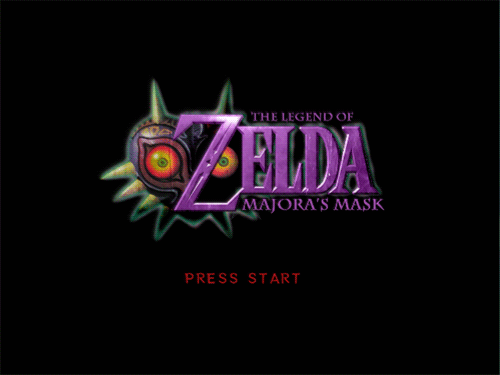
Greetings, Hive! The next game in the list of The Legend of Zelda saga to review after A Link to the Past and Ocarina of Time is the darkest game narratively of the whole saga: The Legend of Zelda: Majora's Mask. Talking about this game is something that excites me a lot because having played it in two different stages of my life gave me a very different perception of it, I had always wanted to do a review about this game and this amazing platform, Hive, gives me the opportunity to do it.
So without any further ado, let's start!

Like its predecessors, Majora's Mask is a game produced and published by Nintendo, released worldwide for the Nintendo 64 in 2000, just two years after Ocarina of Time. It had several re-releases, it appeared in the compilation The Legend of Zelda: Collector's Edition for the Nintendo Game Cube, in Nintendo Wii’s virtual console, and a remake for the Nintendo 3DS that had its release in 2015 with the name "The Legend of Zelda: Majora's Mask 3D", which like Ocarina of Time’s remake, is a version with updated graphics and some changes and additions to the gameplay.
A fun fact is that, as a kid, this game used to scare me a lot, nowadays I even have a Majora's mask tattoo.

Tatto made by Sander Machado
This is the first Zelda game to be a direct sequel, this game takes place after the events of Ocarina of Time: Link defeats Ganon and is returned to his childhood, with Ganon defeated and the kingdom of Hyrule safe, the Master Sword is put to rest again, our companion the fairy Navi having fulfilled her mission entrusted by the Great Deku Tree, is separated from Link, thus culminating our silent protagonist journey. However, as it is revealed that Link is not a Kokiri, but a Hylian, he no longer has a place to return to. This leads him to take the decision to enter the Lost Woods in search of his faithful companion, Navi, leading him to fall into the strange lands of Termina, which are being plagued by the evil of the Skull Kid, bearer of a strange mask known as the Majora's Mask, accompanied by a moon that will hit crash in 72 hours, destroying everything in its path. Obviously, our mission is to stop the Skull Kid and the moon from falling.

Skull Kid. source

Visually, Majora's Mask is very similar to Ocarina of Time, in fact, they use the same graphic engine, but the Nintendo 64 version needed a peripheral called Expansion Pak that increased the memory to improve graphics, have more elements on screen, and in general, give a better performance. As for the gameplay we have the same elements that were presented in the previous installment: third-person view, management in a 3D world of our protagonist, buttons dedicated to actions such as talk, attack, roll, cover; three spaces to equip items (which are practically the same as in Oot). Almost everything we knew is back in this installment.
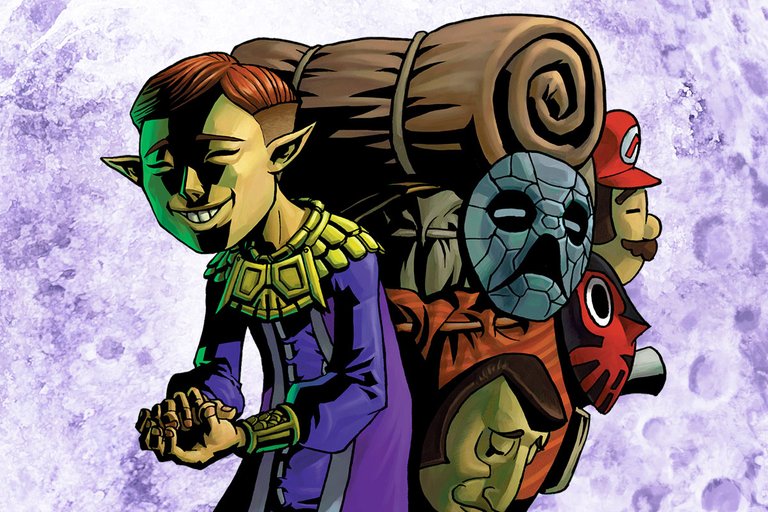
The Happy Masks Salesman source
The first major change in gameplay comes with items that were previously only a secondary part of the game: masks. This time the masks are not just something aesthetic, but these will grant us skills needed to solve or complete specific things when we use them.
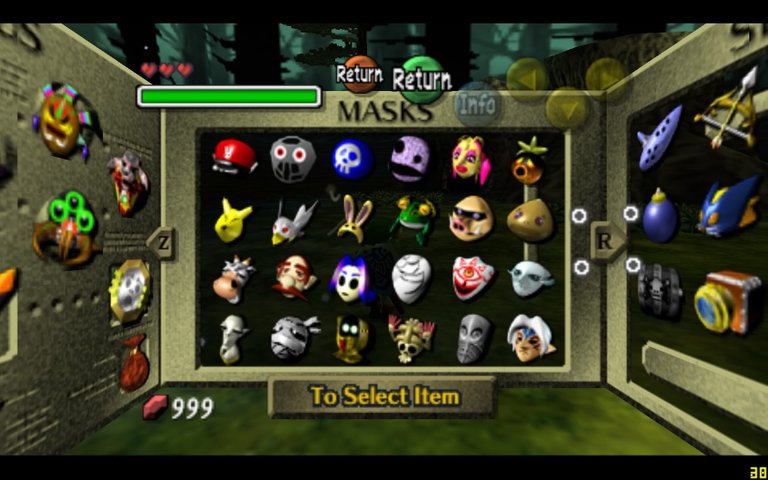
Masks inventory. source
Out of the large repertoire of masks we have to use/get, there are 4 of them that stand out: The Deku mask, the Goron mask, the Zora mask, and the Fierce Deity mask.
These masks are special because they are imbued with the soul of someone of the race they represent, meaning this that, when Links uses them, it transforms into someone of that race, and this brings a GIANT change gameplay as each race has different abilities; as a Deku we are smaller but we can enter the Deku Flowers to glide through the air; the Goron is strong, heavy and has the ability to roll at high speeds; with the Zora we can swim the sea with dexterity and speed; the Fierce Deity is a special mask that we can only use in boss fights, with it we embody a fierce warrior whose power is the only one that can face Majora.
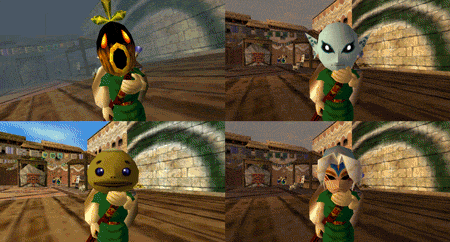
Transformations. source
Finally, the world where we are is perfectly organized with the cardinal points, Clock Town being in the middle and being our base.
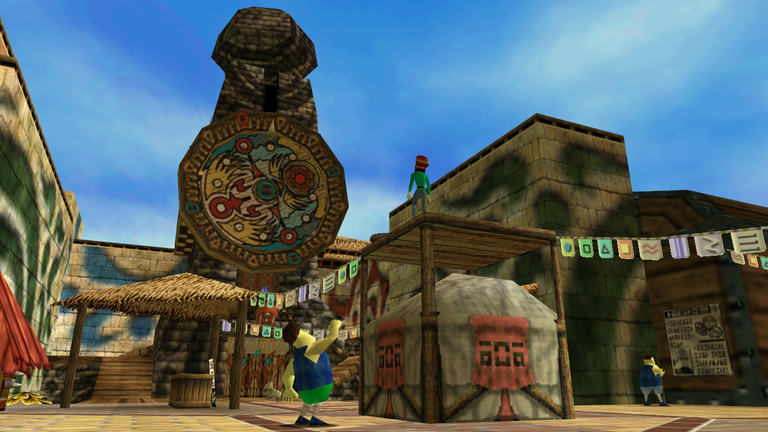
Clock Town. source
The swamp inhabited by the Deku is to the south; the mountains, home of the Goron to the north. The great bay where we find the Zora, lies to the west; and to the east the land of the dead: Ikana Canyon.
In each place we will find a dungeon that we must complete in order to advance the plot, as well as help each of the inhabitant races in their places. The dungeons and the world are adapted to the new mask mechanics, and depending on where we are we will have to use more of a specific mask, for example: in the dungeon of the mountains, our predominant mask will be the Goron mask.

Second and most important change in this installment is time. Interestingly, this game handles the concept of time much better than its predecessor, Ocarina of Time.
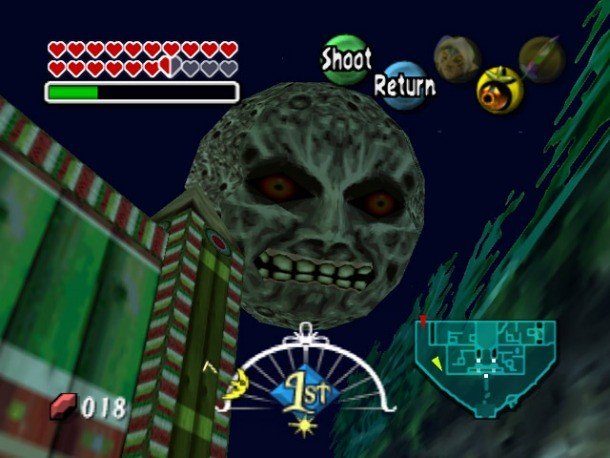
The moon falling... source
The mechanics are as follows: we have 72 hours to prevent the moon from falling on Termina destroying everything in its path, during these three days whenever we look up, we will see the moon, closer and closer, falling little by little and heading to the inevitable end. But 72 hours is too little, and this is where our precious ocarina of time comes in: if we play the song of time we will travel to the past, to the dawn of the first day.
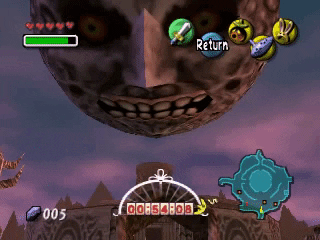
... And falling... source
This resets the 72 hours counter. However, everything we have done so far will be reset as well (except for important items we get in the game), so we can prevent the world from being destroyed while we prepare to fight Majora. There are also other ways to manipulate time with the ocarina: we can make it run slower or skip it, time in this installment feels like another character.

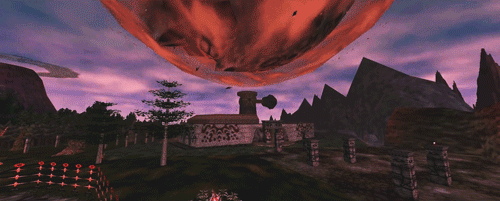
... Until everything's over. source
NPCs (non-playable characters) are also strongly affected by this mechanic; each NPC has its own life and schedule according to the progress of the days, you will not find the same NPC in the same place twice (with few exceptions) and to complete certain side events you will have to be very specific with the schedules and routines of the characters.
That being said... I'd like to talk about the most important part of this review: Majora's Mask's narrative.
The Legend of Zelda is a franchise that is characterized by light stories and narratives, the classic fight of good against evil, this is the exception. Majora's Mask is a game that tells us about the fear of death, sadness and the loss of a loved one and the mourning that we live as a result of it. The inhabitants of Termina are going through very serious problems; a Deku father mourns the disappearance of his son, with no hope of seeing him again; a Zora is in agony, and his greatest regret is that he will not see his children born, and his wife is plunged into a paralyzing depression due to his disappearance; a Goron leader is plunged into despair at not being able to help his people because he’s dead; during our journey Link meets each of these characters and, through the masks, manages to give them eternal rest, however, this is not a story of how Link is the one chosen to save the world. Link is in this world by purely chance, there is no destiny that has planned this for him, and he simply cannot save them all. Each character has a tragic story that unfolds over the three days, and if we help someone we will leave another person unsaved, no matter how fast we are, time keeps passing and we learn to accept that there are things we can't prevent, we learn that there are things we can't change. As the days go by we can see how the inhabitants of Clock Town become more and more scared by the moon, they try to go on with their normal lives but they simply can’t, they know the end is near, their dialogues change and you can feel their fear of dying, their regrets for the things they didn’t do, until finally, on the last day, almost all the inhabitants of Clock Town have evacuated the city in search of shelter.
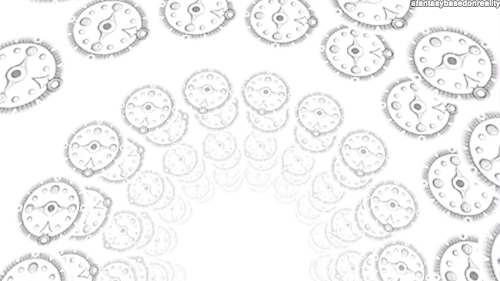
Going back to the dawn of the first day. source
Playing Majora's Mask when I was a kid was always an experience that generated a certain degree of discomfort (discomfort apart from the horrendous moon looking at you all the time) and it wasn't something I understood until I grew up and could begin to understand the issues it addresses, maybe that's why I felt discomfort, I was a kid who didn't understand why those characters were suffering so much. I think that, unfairly, this game has been compared to Ocarina of Time for a long time and people always say things like: "Yes, it's good, but it's not Ocarina of Time", when even though they look and play similar, they have very different themes. Despair, sadness and death are elements that will accompany us throughout this adventure, which perhaps due to administrative decisions was given a happy ending and not the one that was planned or the one that would have been consistent with the theme of the game.

Español | Spanish
Te has encontrado con un terrible destino, ¿verdad?
Vendedor de la máscara feliz

¡Saludos, Hive! El siguiente juego en la lista de la saga de The Legend of Zelda a reseñar después de A Link to the Past y Ocarina of Time es el juego más oscuro narrativamente de toda la saga: The Legend of Zelda: Majora’s Mask. Hablar de este juego es algo que me emociona mucho porque el haberlo jugado en dos etapas distintas de mi vida me dio una percepción muy distinta del mismo, siempre había querido hacer una reseña acerca de este juego y esta increíble plataforma, Hive, me brinda la oportunidad de hacerlo.
Así que sin más preámbulos, ¡comencemos!

Al igual que sus predecesores, Majora’s Mask es un juego producido y publicado por Nintendo, salió al mercado mundial para la Nintendo 64 en el año 2000, tan solo dos años después de Ocarina of Time. Tuvo varios relanzamientos, apareció en el recopilatorio The Legend of Zelda: Collector’s Edition para el Nintendo Game Cube, en la consola virtual del Nintendo Wii, y un remake para la Nintendo 3DS que tuvo su lanzamiento en el 2015 con el nombre de “The Legend of Zelda: Majora’s Mask 3D”, que al igual que el remake de Ocarina of Time para esta consola, es una versión con gráficos actualizados y algunos cambios y añadidos en la jugabilidad.
Un dato curioso es que de niño me daba mucho miedo jugar este juego, hoy en día hasta tengo un tatuaje de la Máscara de Majora.

Tatuaje hecho por Sander Machado
Este es el primer juego de Zelda en ser una secuela directa, este juego toma lugar después de los acontecimientos de Ocarina of Time: Link derrota a Ganon y es devuelto a su niñez, con Ganon derrotado y el reino de Hyrule a salvo, la Espada Maestra es puesta a descansar nuevamente, nuestra compañera el hada Navi habiendo cumplido su misión encomendada por el Gran Árbol Deku, se separa de Link, culminando así el viaje de nuestro silencioso protagonista. Sin embargo, al revelarse que Link no es un Kokiri, sino un Hyliano, ya no tiene un lugar al que volver. Esto lo lleva a tomar la decisión de adentrarse a los Bosques Perdidos en búsqueda de su fiel compañera, Navi, cayendo así en las extrañas tierras de Termina, que están siendo azotadas por la maldad del Skull Kid, portador de una extraña mascara conocida como la Máscara de Majora, acompañados de una luna que impactará en este lugar dentro de 72 horas, destruyéndolo todo a su paso. Obviamente, nuestra misión es detener al Skull Kid y a la luna de caer.

Skull Kid. fuente

Visualmente, Majora’s Mask es muy parecido a Ocarina of Time, de hecho usan el mismo motor gráfico, pero la versión de Nintendo 64 necesitaba de un periférico llamado Expansion Pak que incrementaba la memoria para mejorar los gráficos, tener más elementos en pantalla, y en general, dar un mejor rendimiento. En cuánto a la jugabilidad tenemos los mismos elementos que se nos presentaron en la entrega anterior: vista en tercera persona, manejo en un mundo en 3D de nuestro protagonista, botones dedicados a acciones como hablar, atacar, rodar, cubrirse; tres espacios para equipar objetos (los cuáles son prácticamente los mismos de Oot). Casi todo lo que conocíamos vuelve a hacer presencia en esta entrega.

El vendedor de la máscara feliz. fuente
El primer cambio más importante en la temática y la jugabilidad viene con unos objetos que antes no eran más que una parte secundaria: las máscaras. En esta ocasión las máscaras no son solo algo estético, sino que estas nos otorgaran habilidades necesarias para resolver o completar cosas específicas cuándo las usamos.

Inventario de máscaras. fuente
Del gran repertorio de máscaras que tenemos para usar/conseguir hay 4 de ellas que destacan: La máscara Deku, la máscara Goron, la máscara Zora, y la máscara de la Fiera Deidad.
Estas máscaras son especiales porque están imbuidas con el alma de alguien de la raza que representan, esto hace que, al usarlas, Link se transforme en alguien de esa raza, y esto trae un cambio GIGANTE a la jugabilidad ya que cada raza tiene distintas habilidades; como Deku somos más pequeños pero podemos entrar en las Flores Deku para planear por los aires; el Goron es fuerte, pesado y tiene la habilidad de rodar a grandes velocidades; con el Zora podemos surcar el mar con destreza y velocidad; la Fiera Deidad es una máscara especial que sólo podemos usar en las peleas de jefes, con ella encarnamos a un feroz guerrero cuyo poder es el único que puede hacerle frente a Majora.

Transformaciones. fuente
Termina, el mundo dónde estamos, está perfectamente organizado con los puntos cardinales, Clock Town estando en el medio y siendo nuestra base por así decirlo.

Clock Town. fuente
El pantano habitado por los Deku se encuentra hacia el sur; las montañas, hogar de los Goron al norte; La gran bahía donde nos encontramos a los Zora, al oeste; y hacía el este la tierra de los muertos: El Cañon de Ikana.
En cada lugar encontraremos una mazmorra que debemos completar para avanzar en la trama, así como también ayudar a cada una de las razas habitantes en sus lugares. Las mazmorras y el mundo están adaptados a la nueva mecánica de las máscaras, y dependiendo de dónde estemos tendremos que usar mayor uso de una máscara específica, por ejemplo: en la mazmorra de las montañas, nuestra máscara predominante será la máscara de Goron.

El segundo cambio y el más importante en esta entrega es el tiempo. Curiosamente, este juego maneja mucho mejor el concepto del tiempo que su predecesor, Ocarina of Time.

La luna cayendo... fuente
La mecánica es la siguiente: tenemos 72 horas para impedir que la luna caiga sobre Termina destruyendo todo a su paso, durante estos tres días siempre que miremos hacia arriba, veremos a la luna, cada vez más cerca, cayendo poco a poco y dirigiéndose al inevitable fin. Pero 72 horas son muy poco, y aquí es donde entra nuestra preciada ocarina del tiempo: si tocamos la canción del tiempo vamos a viajar al pasado, al amanecer del primer día.

... Y cayendo... fuente
Esto reinicia el contador de las 72 horas. Sin embargo, todo lo que hayamos hecho hasta el momento será reiniciado también (salvo los objetos importantes que conseguimos en el juego), de esta manera podemos evitar que el mundo sea destruido mientras nos preparamos para nuestro combate con Majora. También hay otras maneras de manipular el tiempo con la ocarina: podemos hacer que corra más lento o adelantarlo, el tiempo en esta entrega se siente como un personaje más.


... Hasta que todo llega a su final. fuente
Los NPC (personajes no jugables) también se ven fuertemente afectados por esta mecánica; cada NPC tiene su propia vida y su propio horario acorde al progreso de los días, no vas a encontrar al mismo NPC en el mismo sitio dos veces (salvo contadas excepciones) y para completar ciertos eventos secundarios tendrás que ser muy específico con los horarios y rutinas de los personajes.
Dicho esto... Me gustaría hablar de la parte más importante de este review: La narrativa de Majora's Mask.
The Legend of Zelda es una franquicia que se caracteriza por historias y narrativas ligeras, la clásica pelea del bien contra el mal, esta es la excepción. Majora’s Mask es un juego que nos habla del miedo a morir, la tristeza y de la pérdida de un ser querido y el luto que vivimos a raíz de ello. Los habitantes de Termina están pasando por problemas muy serios; un padre Deku llora la desaparición de su hijo, sin esperanzas de verlo nuevamente; un Zora se encuentra agonizando, y su mayor pesar es que no verá a sus hijos nacer, y su esposa, se encuentra sumida en una depresión paralizante por su desaparición; un líder Goron se sume en la desesperación de no poder ayudar a su pueblo debido a que está muerto; durante nuestro viaje Link se encuentra con cada uno de estos personajes y, a través de las máscaras, logra darles el descanso eterno, sin embargo, esta no es una historia de cómo Link es el elegido para salvar el mundo. Link está en este mundo por pura casualidad, no hay ningún destino que haya previsto esto para él, y sencillamente no puede salvarlos a todos. Cada personaje tiene una historia trágica que se desarrolla durante los tres días, y si ayudamos a alguien dejaremos a otra persona sin salvar, no importa que tan rápidos seamos, el tiempo sigue pasando y aprendemos a aceptar que hay cosas que no podemos prevenir, aprendemos que hay cosas que no podemos cambiar. A medida que transcurren los días podemos ver como los habitantes de Clock Town están cada vez más asustados por la luna, tratan de seguir con sus vidas normales pero simplemente no pueden, saben que el fin está cerca, sus diálogos cambian y se siente su temor a morir, sus arrepentimientos por las cosas que no hicieron, hasta que finalmente, en el último día, casi todos los habitantes de Clock Town han evacuado la ciudad en búsqueda de refugio.

Regresando al amanecer del primer día. fuente
Jugar Majora’s Mask cuando era niño siempre fue una experiencia que me generaba cierto grado de incomodidad (incomodidad aparte de la horrenda luna mirándote todo el tiempo) y no fue algo que entendí sino hasta que crecí y pude comenzar a entender los temas que aborda, quizás fue por eso, era un niño que no entendía porque esos personajes estaban sufriendo tanto. Creo que, injustamente, este juego ha sido comparado con Ocarina of Time durante mucho tiempo llegándose a decir cosas como: “Si, es bueno, pero no es Ocarina of Time”, cuándo a pesar de que se ven y juegan parecido, tienen temáticas muy distintas. La desesperación, la tristeza y la muerte son elementos que nos acompañaran a lo largo de toda esta aventura, a la que quizás por decisiones administrativas se le dio un final feliz y no el que se tenía planeado o el que hubiese sido consecuente con la temática del juego.


And that’s all for today after revisiting this amazing game, crowed with mystery, theories, music, colors, and mostly: a lot of sadness. What about you? Have you already played Majora’s Mask? Which is your favorite between Oot and MM? I hope you have enjoyed reading this review as much as I did writing it, and, if you haven’t played this awesome game, this encourages you to do it.
Y eso es todo por hoy luego de revisitar este maravilloso juego, lleno de misterios, teorías, música, colores, y sobre todo: mucha tristeza. ¿Y tú? ¿Ya jugaste Majora’s Mask? ¿Cuál es tu favorito entre Oot y MM? Espero que hayas disfrutado esta reseña tanto como yo escribiéndola, y que, si aún no has jugado este increíble juego, esto te anime a hacerlo.

¡Muchas gracias por leerme, nos vemos en el siguiente post! | Thanks a lot for reading, see ya next post!
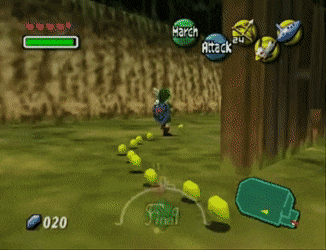
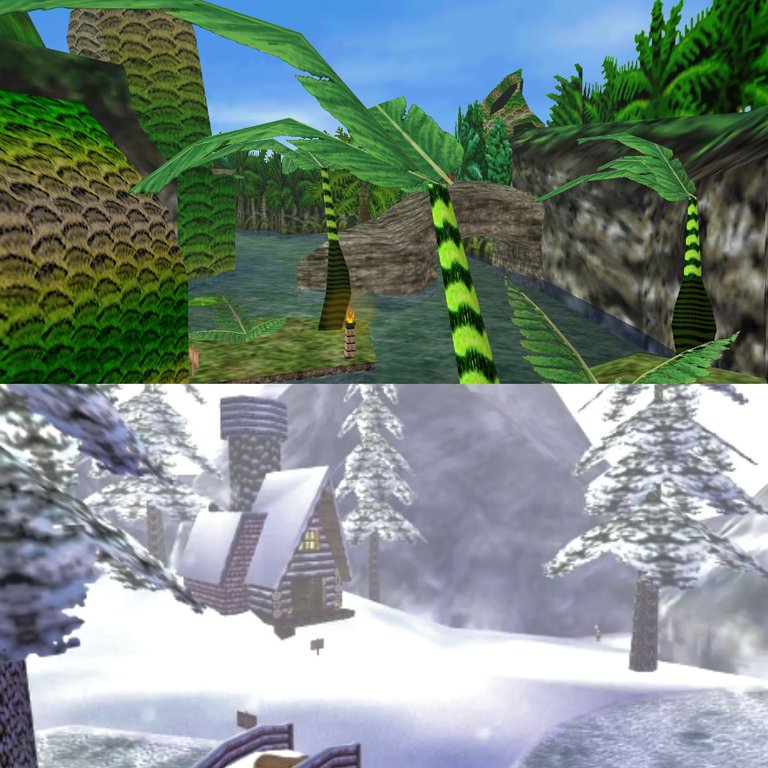
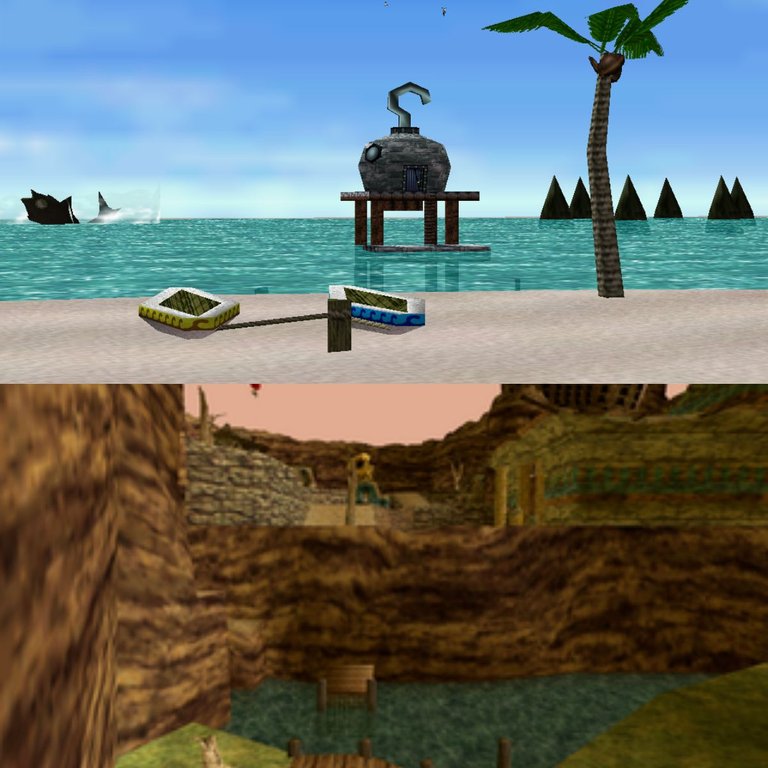
brutal juegazo, amo a zelda y su gran saga, este título en especial no logre jugarlo, pero si he visto bastantes videos sobre el y gracias a tu post tambien pude informarme mas jeje
Que genial que ames Zelda! Cómo se podrá apreciar, yo también 😅 es mi saga favorita. Y si tienes la oportunidad de jugar esta entrega te lo recomiendo ampliamente, no te vas a arrepentir
grax :)
@alejandroaldana! This post has been manually curated by the $PIZZA Token team!
Learn more about $PIZZA Token at hive.pizza. Enjoy a slice of $PIZZA on us!
Great game this. I played it a lot as a kid, even though I had big troubles. I never understood what to do and where to go. I had to watch a friend play it and I basically just memorized everything he did. I remember spending hours on the beach just swimming around doing tricks as a Zora. As I got older I eventually understood English better and was able to beat it. The last boss fight was hard!
Zora Link is my favorite transformation. And, in fact, this a hard game, there weren't so much guides out there telling you what to do. Also accesing information was a lot harder than nowadays. If you don't have the Fierce Diety's mask, you're gonna have a hard time fighting the last boss
Yeah I remember struggling a bit and didn't know what I was doing wrong. That mask was my salvation.
Ocarina of Time se gano mi corazón pero Majora's Mask se gano todo el cariño las mascaras son una de las cosas que me encanto el juego y para mi el mejor antagonista que tiene la saga de Zelda a mi parecer y el final de este Link es el mas triste y ver lo que se convierte en TP me dejo muy impactado
Estoy de acuerdo contigo en cuanto a Majora como el mejor o uno de los mejores antagonistas de la saga. Casi todos los villanos buscan apoderarse del mundo o tienen un objetivo mas "idealizado" por asi decirlo. Majora simplemente es una criatura con ganas de hacer el mal, como si su naturaleza fuese el caos.
Exacto Majora's no era el clasico villano que buscaba revivir a Ganondorf o apoderarse de la trifuerza el solo disfrutaba creando caos, confusión, manipulación y tristeza la verdad es que una de las escena que mas me aterro fue cuando le dice a Skull Kid Que ya no le era mas de utilidad y que solo era una simple marioneta y una vez dentro de la luna las frases de los niños de cada mascara era muy interesante siempre me dejaba en que pensar y la batalla final contra Majora's se puede ver la personalidad en cada transformación que este tiene la verdad que 10/10.
Siempre he considerado Majora Mask como una de las joyas de Zelda más infravalorada, la diferencia que posee en cuanto a historia e inmersión frente a los otros juegos, para mí es lo que lo vuelve completamente atractivo. Cambiando bastante todo lo que hemos visto acerca de la forma en que desenvuelve la historia.
Desafortunadamente es así, Majora sufre de estar "bajo la sombra" de Ocarina, y digo esto entre comillas porque quienes hemos disfrutado ambos juegos de un modo critico, sabemos que Majora es un juego que tiene demasiado que ofrecer por si mismo como para ser comparado o dejado atrás.